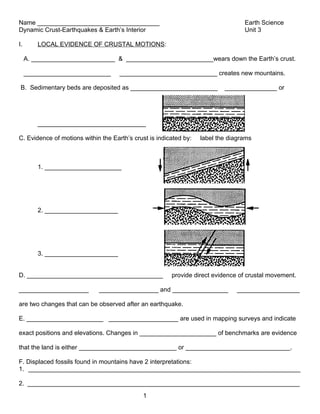
Earth Quake Outline
- 1. Name ___________________________________ Earth Science Dynamic Crust-Earthquakes & Earth’s Interior Unit 3 I. LOCAL EVIDENCE OF CRUSTAL MOTIONS: A. ________________________ & _________________________wears down the Earth’s crust. _________________________ ____________________________ creates new mountains. B. Sedimentary beds are deposited as _________________________ _______________ or _______________________________ C. Evidence of motions within the Earth’s crust is indicated by: label the diagrams 1. ______________________ 2. _____________________ 3. _____________________ D. _______________________________________ provide direct evidence of crustal movement. ____________________ _________________ and ________________ __________________ are two changes that can be observed after an earthquake. E. ______________________ ____________________ are used in mapping surveys and indicate exact positions and elevations. Changes in ______________________ of benchmarks are evidence that the land is either ____________________________ or ______________________________. F. Displaced fossils found in mountains have 2 interpretations: 1. ______________________________________________________________________________ 2. ______________________________________________________________________________ 1
- 2. G. _________________________________ is the RISING OF THE CRUST _________________________________is the SINKING OF THE II. EARTHQUAKES: A. Two processes that cause earthquakes: 1. The movement of _________________________ inside ___________________________. 2. _______________________ is the movement of rock along a surface where the rocks are broken. B. ___________________ movement of the crust over long periods of time builds _______________ within the rocks. Increased pressure causes the ___________________ ______________________ to break creating a _________________________. When faulting occurs energy radiates through the Earth as __________________ ________________ that cause the ground to ________________. III. MEASURING THE EARTHQUAKES: A. There are 2 scales to measure earthquakes 1. ____________________________________ 2. ____________________________________ B. _________________________________ scale is based upon the observations of people and the damage caused. It measures the ____________________ of the earthquake from ______ to ______ C. _________________________ uses the seismograph to determine the _____________________ Magnitude is the total _______________________ released by the earthquake. It’s numerical scale is _________ to _________. Each numeric step represents a _______ increase. 2 IV. PARTS OF THE EARTHQUAKE:
- 3. A. The place underground where the break or fault occurs is the _____________ of the quake The _________________________ is the location along the surface of the earth just above the focus where the quake is felt most strongly A. The two most important energy waves are: ____________________________________________ ____________________________________________ B. Characteristics of P-waves (primary) _________________________________________________ _________________________________________________ _________________________________________________ _________________________________________________ C. Characteristics of S-waves (secondary) ___________________________________________________ ___________________________________________________ ___________________________________________________ ___________________________________________________ D. Both S and P waves travel FASTER through ____________________ material. V. FINDING THE EPICENTER: A. The seismograph records the _____________________________ and ________________________________________________________________________________ (Use the chart on page 11 of your reference table) 3
- 4. Use you Find the Reference best fit Table on the curve page 11 Mark off the difference in and read the arrival time distance of S and P waves on a below piece of paper B. The steps for calculating your distance from the epicenter: 1. ______________________________________________________________________________ 2. ______________________________________________________________________________ 3. ______________________________________________________________________________ 4. ______________________________________________________________________________ Practice Questions: 1. The arrival of the P-wave is 12:03:00 The arrival of an S-wave is 12:07:00 The difference is _____________________ How far is this earthquake from this seismic station? ____________________ 2. The arrival time of the P-wave is 2:05:00 The arrival time of the S-wave is 2:08:00 The difference is: _____________________ How far is this earthquake from the seismic station? _______________________ 3. If the difference in arrival time between P and S waves is 2min. 35 sec. What is the distance from the earthquake to the seismograph station? _________________________ 4. How long does it take for a P-wave to travel from the focus of an earthquake to a seismograph station 2,000 km. away? _______________________________ How long will the S-wave take to travel to this same station? ______________________ 5. What is the difference in arrival time between P and S waves for an earthquake that is 5,000 kilometers away from the seismograph station? ______________________________ 4
- 5. VII. THE ORIGIN TIME OF AN EARTHQUAKE: A. An earthquake wave detected at __________________________ times by observers at ____________________ distances from the epicenter. B. To find the origin time seismologists need to know: 1. _____________________________________________________________________ 2. _____________________________________________________________________ Example: A seismograph recording station located 5,700 kilometers from an epicenter. It receives a P-wave at 2:45 P.M. At what time did the earthquake actually occur at the epicenter? VIII. THE LAYERS OF THE EARTH: A. The crusts thickness ______________________. It is __________________ under the oceans and ____________________ under the continents. Continental crust is mostly ____________, __________ density & _________________________ The ocean basins are mostly ______________ and ________________ or __________________ B. Inferred characteristics of the Earth’s Interior: 1. Studying the ____________________________ of ______________________ _________________ allows us to make inferences about the structure and composition of the Earth’s interior. 2. The _______________________ of a seismic wave changes with the ________________ of the material it travels through. Waves are also ___________________________________ as they travel through materials with different densities. We know that P-waves can be transmitted through ___________ __________ & ___________ S-Waves can be transmitted through ONLY ________________ 3. Earth Quake Shadow Zones: When an earthquake occurs both ____________ are received from most of the earth. Opposite sides of the earth where the epicenter is, receives ____ but NO _______ because S-waves cannot penetrate the ________________ outer core. ______________________ (bending) occurs at the __________________ ( boundaries) 5
- 6. Draw a diagram of the earth’s interior and label and describe each layer or part: A- Inner Core: B- Outer Core: C- Moho: D- Mantle: E- Crust: 6